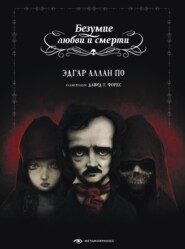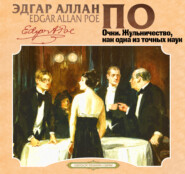По всем вопросам обращайтесь на: info@litportal.ru
(©) 2003-2024.
✖
The Narrative of Arthur Gordon Pym of Nantucket
Автор
Год написания книги
2019
Настройки чтения
Размер шрифта
Высота строк
Поля
The Narrative of Arthur Gordon Pym of Nantucket
Edgar Allan Poe
HarperCollins is proud to present its incredible range of best-loved, essential classics.‘It was unnecessary for all to perish, when, by the death of one, it was possible, and even probable, that the rest might be finally preserved.’Travelling aboard a whaling vessel, a young stowaway is swept up in myriad misadventures – mutiny, shipwreck, cannibalism – narrowly escaping numerous brushes with death. This rousing story of a daring sea voyage also presents its antihero with a host of psychological dilemmas, and offers an important insight into Poe’s work as a whole.The only complete novel by infamous gothic horror writer Edgar Allan Poe, ‘The Narrative of Arthur Gordon Pym of Nantucket’ has inspired other classic tales of maritime adventure, such as Herman Melville’s ‘Moby-Dick’ and Jules Verne’s ‘Twenty Thousand Leagues Under the Sea’.
THE NARRATIVE OF ARTHUR GORDON PYM OF NANTUCKET
Edgar Allan Poe
Copyright (#ulink_b7cb9cf9-1526-57af-9845-ff7f434d7a5b)
William Collins
An imprint of HarperCollinsPublishers
1 London Bridge Street,
London SE1 9GF
WilliamCollinsBooks.com (http://WilliamCollinsBooks.com)
This eBook edition published by William Collins in 2016
Life & Times section © HarperCollinsPublishers Ltd
Gerard Cheshire asserts his moral right as author of the Life & Times section
Classic Literature: Words and Phrases adapted from
Collins English Dictionary
Cover by e-Digital Design
Cover image: Catching Whales, 1875, Rasmussen, J. E. Carl (1841 – 93) / Private Collection / Photo © Gavin Graham Gallery, London, UK / Bridgeman Images
A catalogue record for this book is available from the British Library.
All rights reserved under International and Pan-American Copyright Conventions. By payment of the required fees, you have been granted the non-exclusive, non-transferable right to access and read the text of this e-book on-screen. No part of this text may be reproduced, transmitted, down-loaded, decompiled, reverse engineered, or stored in or introduced into any information storage and retrieval system, in any form or by any means, whether electronic or mechanical, now known or hereinafter invented, without the express written permission of HarperCollins.
Source ISBN: 9780008166779
Ebook Edition © January 2016 ISBN: 9780008166786
Version: 2015-12-04
History of Collins (#ulink_1fb4cb24-3bcc-5135-b2da-847d4917791d)
In 1819, millworker William Collins from Glasgow, Scotland, set up a company for printing and publishing pamphlets, sermons, hymn books, and prayer books. That company was Collins and was to mark the birth of HarperCollins Publishers as we know it today. The long tradition of Collins dictionary publishing can be traced back to the first dictionary William published in 1824, Greek and English Lexicon. Indeed, from 1840 onwards, he began to produce illustrated dictionaries and even obtained a licence to print and publish the Bible.
Soon after, William published the first Collins novel, Ready Reckoner; however, it was the time of the Long Depression, where harvests were poor, prices were high, potato crops had failed, and violence was erupting in Europe. As a result, many factories across the country were forced to close down and William chose to retire in 1846, partly due to the hardships he was facing.
Aged 30, William’s son, William II, took over the business. A keen humanitarian with a warm heart and a generous spirit, William II was truly ‘Victorian’ in his outlook. He introduced new, up-to-date steam presses and published affordable editions of Shakespeare’s works and ThePilgrim’s Progress, making them available to the masses for the first time. A new demand for educational books meant that success came with the publication of travel books, scientific books, encyclopedias, and dictionaries. This demand to be educated led to the later publication of atlases, and Collins also held the monopoly on scripture writing at the time.
In the 1860s Collins began to expand and diversify and the idea of ‘books for the millions’ was developed. Affordable editions of classical literature were published, and in 1903 Collins introduced 10 titles in their Collins Handy Illustrated Pocket Novels. These proved so popular that a few years later this had increased to an output of 50 volumes, selling nearly half a million in their year of publication. In the same year, The Everyman’s Library was also instituted, with the idea of publishing an affordable library of the most important classical works, biographies, religious and philosophical treatments, plays, poems, travel, and adventure. This series eclipsed all competition at the time, and the introduction of paperback books in the 1950s helped to open that market and marked a high point in the industry.
HarperCollins is and has always been a champion of the classics, and the current Collins Classics series follows in this tradition – publishing classical literature that is affordable and available to all. Beautifully packaged, highly collectible, and intended to be reread and enjoyed at every opportunity.
Life & Times (#ulink_126902d0-75ef-59f4-b801-b9bf7a9cdc68)
About the Author
Edgar Allan Poe was an American writer of fantastical, bizarre and sometimes disturbing short stories. He lived and worked in the first half of the 19th century and died a mysterious death, many believe caused by an overdose of drugs, at the age of 40. It seems likely that Poe was himself inclined towards obsessive and unbalanced behaviour. As a child his father abandoned the family and his mother died shortly thereafter, leaving him an orphan. He was taken in by the Allan family; however, they endured a strained relationship and he became estranged from them when he failed to complete university and then to become an army officer. For the years that followed, he wrote poetry and then prose, contributing to and working for many periodicals and journals of the time. For the most part of his career, Poe was known for being a literary critic rather than an author. In 1835, Poe married his 13-year-old cousin in secret, and 10 years later wrote perhaps his most well-known poem, ‘The Raven’.
Poe’s work is usually described as ‘Gothic’ in style, as he alludes to the macabre, grotesque and horrifying. Poe used the phrase ‘terrors of the soul’ in explaining the primary focus of investigation in his prose and poetry. He was clearly preoccupied with delving into the darker reaches of the human psyche to see what he could find.
In the 1960s he became an influence on British pop music due to his highly imaginative literary imagery. The Beatles included a portrait of Poe on the cover of their 1967 album Sgt. Pepper’s Lonely Hearts Club Band and John Lennon mentions Poe in the song ‘I Am The Walrus’, released later that same year. The Beatles were heavily influenced by experimentation with hallucinogenic drugs such as LSD (lysergic acid diethylamide) and many felt that reading Poe’s work was akin to the kind of psychological experiences elicited by hallucinogens. It may have been that Poe used them himself to enter his unique literary realm.
His Works
Tales of Mystery and Imagination was first compiled and published in 1908, some 59 years after Poe’s untimely death. There had been other canons of his writing, but this one focused specifically on the darker side of his work, omitting poetry and comic prose. Perhaps the most regarded of the short stories therein is The Murders in the Rue Morgue, originally published in 1841. In this story Poe invents the first literary detective, named Auguste Dupin, who sets about solving the mysterious double murder of a Parisian lady and her daughter in a street named Rue Morgue (Mortuary Street). A man has been wrongly accused and Dupin, having found an auburn-coloured hair, deduces a most unlikely culprit. Further investigation shows Dupin to be correct. The story is the first example of a fictional crime solved by the principle of deduction based on ingenuity, evidence and reason. It set the benchmark for later literary detectives, such as Sherlock Holmes and Hercule Poirot.
In The Fall of the House of Usher, originally published in 1839, Poe delves into matters of psychological illness, with the central character Roderick Usher, suffering from all manner of mental disturbances. In Poe’s day, psychiatry had not yet defined specific conditions, but Roderick Usher had overly sensitive physical senses, an obsession with getting ill and was filled with extreme angst and anxiety about life. These days these symptoms would be classified respectively as hyperaesthesia, hypochondria and hysteria. Roderick Usher lives in large house, where his sister has recently died and awaits being interred in the family tomb. The narrator of the story has come to stay with Roderick and witnesses various spooky events, whilst Roderick himself grows increasingly disturbed. The narrator reads Roderick a story to distract him, but this only serves to make things worse as the events in the story seem to embody themselves elsewhere in the house, and the narrator flees in fright.
His first critical success came when he published his famous narrative poem ‘The Raven’ in 1845. Again, it was an exploration into mental illness and madness. In 1847 his wife Clemm died of tuberculosis. She had been with Poe for 12 years and when she died Poe went into a decline. He became depressed and apathetic, turned to alcohol, and only a few years later came to the end of his own life. A man named Joseph Walker had found Poe walking the streets of Baltimore in an incoherent and distressed condition. He was taken to hospital but his condition worsened and he died four days later. He had never been lucid enough to explain what had happened to him just prior to his death.
The Narrative of Arthur Gordon Pym of Nantucket
The Narrative of Arthur Gordon Pym of Nantucket is Edgar Allan Poe’s only completed novel, a collection of ponderings which form an adventurous ocean journey.
Published in 1838, the novel is now regarded as a prototype for the genre, influencing authors such as Jules Verne and Herman Melville. Poe was writing in the mid-nineteenth century, when explorers were expanding the limits of the known world and sharing exotic myths, legends and artifacts from their travels. The interiors of Africa and South America were not yet mapped, and Antarctica was yet to be explored at all. To many readers, and especially to those of the nineteenth-century, there is something thrilling about the idea of embarking on an expedition into the unknown.
The novel structure was not yet fully established when Poe was writing, and this gave an opportunity for experimentation with form and style. The novel is written in a free-form manner, almost as if the tale is a sequence of dreams hurriedly scribbled down upon awaking. Poe eventually found that the short-story format was better suited to his style (see ‘His Works’), and he is probably best known for these, and for his narrative poem ‘The Raven’.
Some regarded The Narrative of Arthur Gordon Pym of Nantucket as the work of genius, while others dismissed it as the ramblings of madness, and this polarized view of the novel persists to this day. Poe himself later disparagingly mentioned his novel in a letter: ‘You once wrote in your magazine a sharp critique upon a book of mine – a very silly book – Pym.’
CONTENTS
Cover (#uec0e0db9-c4df-5bd4-b898-0959497c987f)
Title Page (#u2cdada49-71c5-564d-ac37-3bf20c717308)
Copyright (#u28039670-2389-50c2-8cff-55b8efaebdda)
History of Collins (#u70ca314c-5901-54ad-b73b-a8a2b033080c)
Life & Times (#u419f2ecc-349e-5a2d-9ebe-0df0139d59a9)
Preface (#u30220a74-1a3f-511a-9feb-47d01de624c3)
Chapter 1 (#u69594c3c-5d3f-5fcf-a485-71831c2619fb)
Edgar Allan Poe
HarperCollins is proud to present its incredible range of best-loved, essential classics.‘It was unnecessary for all to perish, when, by the death of one, it was possible, and even probable, that the rest might be finally preserved.’Travelling aboard a whaling vessel, a young stowaway is swept up in myriad misadventures – mutiny, shipwreck, cannibalism – narrowly escaping numerous brushes with death. This rousing story of a daring sea voyage also presents its antihero with a host of psychological dilemmas, and offers an important insight into Poe’s work as a whole.The only complete novel by infamous gothic horror writer Edgar Allan Poe, ‘The Narrative of Arthur Gordon Pym of Nantucket’ has inspired other classic tales of maritime adventure, such as Herman Melville’s ‘Moby-Dick’ and Jules Verne’s ‘Twenty Thousand Leagues Under the Sea’.
THE NARRATIVE OF ARTHUR GORDON PYM OF NANTUCKET
Edgar Allan Poe
Copyright (#ulink_b7cb9cf9-1526-57af-9845-ff7f434d7a5b)
William Collins
An imprint of HarperCollinsPublishers
1 London Bridge Street,
London SE1 9GF
WilliamCollinsBooks.com (http://WilliamCollinsBooks.com)
This eBook edition published by William Collins in 2016
Life & Times section © HarperCollinsPublishers Ltd
Gerard Cheshire asserts his moral right as author of the Life & Times section
Classic Literature: Words and Phrases adapted from
Collins English Dictionary
Cover by e-Digital Design
Cover image: Catching Whales, 1875, Rasmussen, J. E. Carl (1841 – 93) / Private Collection / Photo © Gavin Graham Gallery, London, UK / Bridgeman Images
A catalogue record for this book is available from the British Library.
All rights reserved under International and Pan-American Copyright Conventions. By payment of the required fees, you have been granted the non-exclusive, non-transferable right to access and read the text of this e-book on-screen. No part of this text may be reproduced, transmitted, down-loaded, decompiled, reverse engineered, or stored in or introduced into any information storage and retrieval system, in any form or by any means, whether electronic or mechanical, now known or hereinafter invented, without the express written permission of HarperCollins.
Source ISBN: 9780008166779
Ebook Edition © January 2016 ISBN: 9780008166786
Version: 2015-12-04
History of Collins (#ulink_1fb4cb24-3bcc-5135-b2da-847d4917791d)
In 1819, millworker William Collins from Glasgow, Scotland, set up a company for printing and publishing pamphlets, sermons, hymn books, and prayer books. That company was Collins and was to mark the birth of HarperCollins Publishers as we know it today. The long tradition of Collins dictionary publishing can be traced back to the first dictionary William published in 1824, Greek and English Lexicon. Indeed, from 1840 onwards, he began to produce illustrated dictionaries and even obtained a licence to print and publish the Bible.
Soon after, William published the first Collins novel, Ready Reckoner; however, it was the time of the Long Depression, where harvests were poor, prices were high, potato crops had failed, and violence was erupting in Europe. As a result, many factories across the country were forced to close down and William chose to retire in 1846, partly due to the hardships he was facing.
Aged 30, William’s son, William II, took over the business. A keen humanitarian with a warm heart and a generous spirit, William II was truly ‘Victorian’ in his outlook. He introduced new, up-to-date steam presses and published affordable editions of Shakespeare’s works and ThePilgrim’s Progress, making them available to the masses for the first time. A new demand for educational books meant that success came with the publication of travel books, scientific books, encyclopedias, and dictionaries. This demand to be educated led to the later publication of atlases, and Collins also held the monopoly on scripture writing at the time.
In the 1860s Collins began to expand and diversify and the idea of ‘books for the millions’ was developed. Affordable editions of classical literature were published, and in 1903 Collins introduced 10 titles in their Collins Handy Illustrated Pocket Novels. These proved so popular that a few years later this had increased to an output of 50 volumes, selling nearly half a million in their year of publication. In the same year, The Everyman’s Library was also instituted, with the idea of publishing an affordable library of the most important classical works, biographies, religious and philosophical treatments, plays, poems, travel, and adventure. This series eclipsed all competition at the time, and the introduction of paperback books in the 1950s helped to open that market and marked a high point in the industry.
HarperCollins is and has always been a champion of the classics, and the current Collins Classics series follows in this tradition – publishing classical literature that is affordable and available to all. Beautifully packaged, highly collectible, and intended to be reread and enjoyed at every opportunity.
Life & Times (#ulink_126902d0-75ef-59f4-b801-b9bf7a9cdc68)
About the Author
Edgar Allan Poe was an American writer of fantastical, bizarre and sometimes disturbing short stories. He lived and worked in the first half of the 19th century and died a mysterious death, many believe caused by an overdose of drugs, at the age of 40. It seems likely that Poe was himself inclined towards obsessive and unbalanced behaviour. As a child his father abandoned the family and his mother died shortly thereafter, leaving him an orphan. He was taken in by the Allan family; however, they endured a strained relationship and he became estranged from them when he failed to complete university and then to become an army officer. For the years that followed, he wrote poetry and then prose, contributing to and working for many periodicals and journals of the time. For the most part of his career, Poe was known for being a literary critic rather than an author. In 1835, Poe married his 13-year-old cousin in secret, and 10 years later wrote perhaps his most well-known poem, ‘The Raven’.
Poe’s work is usually described as ‘Gothic’ in style, as he alludes to the macabre, grotesque and horrifying. Poe used the phrase ‘terrors of the soul’ in explaining the primary focus of investigation in his prose and poetry. He was clearly preoccupied with delving into the darker reaches of the human psyche to see what he could find.
In the 1960s he became an influence on British pop music due to his highly imaginative literary imagery. The Beatles included a portrait of Poe on the cover of their 1967 album Sgt. Pepper’s Lonely Hearts Club Band and John Lennon mentions Poe in the song ‘I Am The Walrus’, released later that same year. The Beatles were heavily influenced by experimentation with hallucinogenic drugs such as LSD (lysergic acid diethylamide) and many felt that reading Poe’s work was akin to the kind of psychological experiences elicited by hallucinogens. It may have been that Poe used them himself to enter his unique literary realm.
His Works
Tales of Mystery and Imagination was first compiled and published in 1908, some 59 years after Poe’s untimely death. There had been other canons of his writing, but this one focused specifically on the darker side of his work, omitting poetry and comic prose. Perhaps the most regarded of the short stories therein is The Murders in the Rue Morgue, originally published in 1841. In this story Poe invents the first literary detective, named Auguste Dupin, who sets about solving the mysterious double murder of a Parisian lady and her daughter in a street named Rue Morgue (Mortuary Street). A man has been wrongly accused and Dupin, having found an auburn-coloured hair, deduces a most unlikely culprit. Further investigation shows Dupin to be correct. The story is the first example of a fictional crime solved by the principle of deduction based on ingenuity, evidence and reason. It set the benchmark for later literary detectives, such as Sherlock Holmes and Hercule Poirot.
In The Fall of the House of Usher, originally published in 1839, Poe delves into matters of psychological illness, with the central character Roderick Usher, suffering from all manner of mental disturbances. In Poe’s day, psychiatry had not yet defined specific conditions, but Roderick Usher had overly sensitive physical senses, an obsession with getting ill and was filled with extreme angst and anxiety about life. These days these symptoms would be classified respectively as hyperaesthesia, hypochondria and hysteria. Roderick Usher lives in large house, where his sister has recently died and awaits being interred in the family tomb. The narrator of the story has come to stay with Roderick and witnesses various spooky events, whilst Roderick himself grows increasingly disturbed. The narrator reads Roderick a story to distract him, but this only serves to make things worse as the events in the story seem to embody themselves elsewhere in the house, and the narrator flees in fright.
His first critical success came when he published his famous narrative poem ‘The Raven’ in 1845. Again, it was an exploration into mental illness and madness. In 1847 his wife Clemm died of tuberculosis. She had been with Poe for 12 years and when she died Poe went into a decline. He became depressed and apathetic, turned to alcohol, and only a few years later came to the end of his own life. A man named Joseph Walker had found Poe walking the streets of Baltimore in an incoherent and distressed condition. He was taken to hospital but his condition worsened and he died four days later. He had never been lucid enough to explain what had happened to him just prior to his death.
The Narrative of Arthur Gordon Pym of Nantucket
The Narrative of Arthur Gordon Pym of Nantucket is Edgar Allan Poe’s only completed novel, a collection of ponderings which form an adventurous ocean journey.
Published in 1838, the novel is now regarded as a prototype for the genre, influencing authors such as Jules Verne and Herman Melville. Poe was writing in the mid-nineteenth century, when explorers were expanding the limits of the known world and sharing exotic myths, legends and artifacts from their travels. The interiors of Africa and South America were not yet mapped, and Antarctica was yet to be explored at all. To many readers, and especially to those of the nineteenth-century, there is something thrilling about the idea of embarking on an expedition into the unknown.
The novel structure was not yet fully established when Poe was writing, and this gave an opportunity for experimentation with form and style. The novel is written in a free-form manner, almost as if the tale is a sequence of dreams hurriedly scribbled down upon awaking. Poe eventually found that the short-story format was better suited to his style (see ‘His Works’), and he is probably best known for these, and for his narrative poem ‘The Raven’.
Some regarded The Narrative of Arthur Gordon Pym of Nantucket as the work of genius, while others dismissed it as the ramblings of madness, and this polarized view of the novel persists to this day. Poe himself later disparagingly mentioned his novel in a letter: ‘You once wrote in your magazine a sharp critique upon a book of mine – a very silly book – Pym.’
CONTENTS
Cover (#uec0e0db9-c4df-5bd4-b898-0959497c987f)
Title Page (#u2cdada49-71c5-564d-ac37-3bf20c717308)
Copyright (#u28039670-2389-50c2-8cff-55b8efaebdda)
History of Collins (#u70ca314c-5901-54ad-b73b-a8a2b033080c)
Life & Times (#u419f2ecc-349e-5a2d-9ebe-0df0139d59a9)
Preface (#u30220a74-1a3f-511a-9feb-47d01de624c3)
Chapter 1 (#u69594c3c-5d3f-5fcf-a485-71831c2619fb)

















